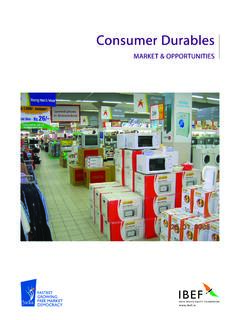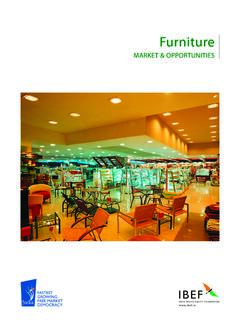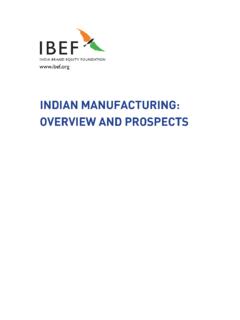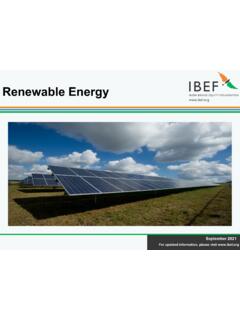Transcription of FAST MOVING CONSUMER GOODS (FMCG) - ibef.org
1 For updated information, please visit April 2018 FAST MOVING CONSUMER GOODS (FMCG) Table of Content Advantage 4 Market Overview and Strategies Growth Case Industry Porters Five Forces Executive Useful For updated information, please visit FMCG 3 EXECUTIVE SUMMARY Total consumption expenditure (US$ billion) 1,595 3,600 01,0002,0003,0004,00020162020 FRural FMCG market in India (US$ billion) 29 100 220 05010015020025020162020F2025 FFMCG market in India (US$ billion) Source: World Bank, emami Reports, Dabur Reports, AC Nielsen Notes: F- Forecast 49 104 05010015020162020F Favourable demographics and rise in income level to boost FMCG market FMCG market in India is expected to grow at a CAGR of per cent and is expected to reach US$ billion by 2020 from US$ 49 billion in 2016 Total consumption expenditure is set to increase at a CAGR of per cent from 2016-2021. Total consumption expenditure is expected to reach nearly US$ 3600 billion by 2020 from US$ 1,595 billion in 2016 Rise in rural consumption to drive the FMCG market The rural FMCG market in India is expected to grow to US$ 220 billion by 2025 from US$ billion in 2016 CAGR CAGR FMCG ADVANTAGE INDIA For updated information, please visit FMCG 5 ADVANTAGE INDIA Rising incomes and growing youth population have been key growth drivers of the sector.
2 Brand consciousness has also aided demand India s CONSUMER spending is expected to increase to US$ trillion by 2020 and India s contribution to global consumption is expected to more than double to per cent by 2020.* Tier II/III cities are witnessing faster growth in modern trade Low penetration levels in rural market offers room for growth Disposable income in rural India has increased due to the direct cash transfer scheme Exports is another growing segment E-commerce companies like Amazon are strengthening their business in FMCG sector, by positioning their platform pantry as front line offering to drive daily products sales. Many players are expanding into new geographies and categories Modern retail share is expected to triple its growth from US$60 billion in 2015 to US$180 billion in 2020 With an investment of US$ million, Wipro is diversifying and expanding its product range in energy drinks, detergents and fabric conditioners.
3 Patanjali will spend US$ million in various food parks in Maharashtra, Assam, Andhra Pradesh and Uttar Pradesh. Investment approval of up to 100 per cent foreign equity in single brand retail and 51 per cent in multi-brand retail Initiatives like Food Security Bill and direct cash transfer subsidies reach about 40 per cent of households in India The minimum capitalisation for foreign FMCG companies to invest in India is US$100 million ADVANTAGE INDIA Source: emami Note: E Estimated, F Forecast, * - as per a report by BCG and CII FMCG MARKET OVERVIEW AND TRENDS For updated information, please visit FMCG 7 EVOLUTION OF FMCG IN INDIA Source: Dabur annual report , Economic Times, emami annual report , McKinsey Global Institute, CII, Boston Consulting Group report FY00 FY17 Indian FMCG Industry US$ 9 billion Market size of chocolates - <US$ 100 million Market size of personal care - <US$ 3 billion HUL s share in FMCG market (personal care) - >50% Indian FMCG Industry US$ 49 billion Market size of chocolates US$ 1, million Market size of personal care US$ billion HUL s share in FMCG market (personal care) FMCG is the 4th largest sector in the Indian economy Household and Personal Care is the leading segment, accounting for 50 per cent of the overall market.
4 Hair care (23 per cent) and Food and Beverages (19 per cent) comes next in terms of market share Growing awareness, easier access and changing lifestyles have been the key growth drivers for the sector The number of online users in India is likely to cross 850 million by 2025. Retail market in India is estimated to reach US$ trillion by 2020 from US$ 672 billion in 2016, with modern trade expected to grow at 20 per cent - 25 per cent per annum, which is likely to boost revenues of FMCG companies People are gracefully embracing Ayurveda products, which has resulted in growth of FMCG major, Patanjali Ayurveda, with a revenue of US$ billion in FY17. The company aims to expand globally in the next 5 to 10 years. For updated information, please visit FMCG 8 THREE MAIN SEGMENTS OF FMCG Food and Beverages Healthcare Household and Personal Care It accounts for 19 per cent of the sector. This segment includes health beverages, staples/cereals, bakery products, snacks, chocolates, ice cream, tea/coffee/soft drinks, processed fruits and vegetables, dairy products, and branded flour It accounts for 31 per cent of the sector.
5 This segment includes OTC products and ethicals. It accounts for 50 per cent of the sector. This segment includes oral care, hair care, skin care, cosmetics/deodorants, perfumes, feminine hygiene and paper products, Fabric wash, household cleaners FMCG Note: OTC is over the counter products; ethicals are a range of pharma products, Data as of March 2016 Source: Dabur For updated information, please visit FMCG 9 Note: F Forecast, ^ - according to Euromonitor International, #As per ICICI securities Source: Dabur, AC Nielsen The FMCG sector in India generated revenues worth US$ 49 billion in 2016. By 2020, the revenues of the sector are forecasted to reach US$ 104 billion In the long run, with the system becoming more transparent and easily compliable, demonetisation is expected to benefit organised players in the FMCG industry. The sector is estimated to have witnessed revenue growth of per cent in October-December 2017, supported by improvement in CONSUMER sentiment and rise in rural demand.
6 # Direct selling sector in India is expected to reach Rs billion (US$ billion) by 2021, if provided with a conducive environment through reforms and regulation. Edible oil market in India grew by per cent in 2017 to cross Rs trillion (US$ billion). ^ The focus on agriculture, MSMEs, education, healthcare, infrastructure and employment under the Union Budget 2018-19 is expected to directly impact the FMCG sector. These initiatives are expected to increase the disposable income in the hands of the common people, especially in the rural area, which will be beneficial for the sector. The FMCG sector is expected to register net revenue growth of per cent in Q4 March 2018 due to accelerated volume growth, GST led savings and higher leverage benefits. Visakhapatnam port traffic (million tonnes) Trends in FMCG revenues over the years (US$ billion) GROWTH IN INDIAN FMCG SECTOR For updated information, please visit FMCG 10 FOOD AND PERSONAL CARE ACCOUNT FOR 2/3rd SHARE IN REVENUES Source: Dabur Visakhapatnam port traffic (million tonnes) Revenue share of India (FY16) Hair Care is the leading segment, accounting for 23 per cent of the overall market in terms of revenue.
7 Food Products is the 2nd leading segment of the sector accounting for 19 per cent followed by health supplements and oral care which has a market share of 16 per cent and 15 per cent, respectively. As of FY17, the contribution of herbal products to the overall personal care products market in India stood at 6-7 per cent and is estimated to grow to 10 per cent by FY20. The beauty, cosmetics and grooming market in India is expected to reach US$ 20 billion by 2025 from US$ billion currently. As increasing number of customers are adopting the natural way of life, demand for Ayurvedic and herbal products is expected to grow at a strong rate going forward. 23% 18% 18% 15% 9% 6% 6% 5% HaircareFoodsHealth SupplementsOral CareOTC & EthicalsHome CareDigestivesSkin Care23% For updated information, please visit FMCG 11 URBAN MARKET ACCOUNTS FOR MAJOR CHUNK OF REVENUES Source: BCG , KPMG- , Deloitte report , Winning in India s Retail Sector Urban Rural industry Breakup (FY2016-17) Note: E estimate, ^ - as per a report by State Bank of India Accounting for a revenue share of around 60 per cent, rural segment is the largest contributor to the overall revenue generated by the FMCG sector in India and recorded a market size of around US$ billion in 2016-17.
8 Semi-urban and urban segments are growing at a rapid pace and accounted for a revenue share of 40 per cent in the overall revenues recorded by FMCG sector in India. In the last few years, the FMCG market has grown at a faster pace in rural India compared with urban India. FMCG products account for 50 per cent of total rural spending. Demand for quality GOODS and services has been going up in rural areas of India, on the back of improved distribution channels of manufacturing and FMCG companies.^ 60% 40% US$ 49 billion RuralUrbanFor updated information, please visit FMCG 12 RURAL SEGMENT IS QUICKLY CATCHING UP In FY17, rural India accounted for 60 per cent of the total FMCG market. Total rural income, which is currently at around US$ 572 billion, is projected to reach US$ trillion by FY21. India s rural per capita disposable income is estimated to increase at a CAGR of per cent to US$ 631 by 2020. As income levels are rising, there is also a clear uptrend in the share of non-food expenditure in rural India.
9 The Fast MOVING CONSUMER GOODS (FMCG) sector in rural and semi-urban India is estimated to cross US$ 220 billion by 2025 Amongst the leading retailers, Dabur generates over 40-45 per cent of its domestic revenue from rural sales. HUL rural revenue accounts for 45 per cent of its overall sales while other companies earn 30- 35 per cent of their revenues from rural areas. Note: F-Forecast Source: AC Nielsen, Dabur Reports, Goderej Group, McKinsey Global Institute Rural FMCG Market (US$ billion) updated information, please visit FMCG 13 INCREASING SALES OF TOP FMCG COMPANIES Sales (US$ million) Source: Company Websites CONSUMER products manufacturers ITC, Godrej CONSUMER Products Limited (GCPL) and HUL reported healthy net sales in FY17. Aggregate financial performance of the leading 10 FMCG companies over the past 8 quarters displays that the industry has grown at an average 16-21 per cent in the past 2 years.
10 In December 2016, Godrej CONSUMER Products Ltd (GCPL) acquired remaining 49 per cent in Kenyan Co Charm Industries Reckitt Benckiser, posted 14 per cent growth in sales in FY16, on the back of a forced distribution push in rural market, in support from the Swach Bharat Campaign. Biscuits and confectionery maker - Parle Products, is aiming to increase its market share in the premium biscuits category from 15 per cent in 2016 17 to around 20 per cent by 2017-18. Indian biscuits giant, Britannia Industries Ltd (BIL), is setting up its largest plant ever, in Ranjangaon, Maharashtra, with an investment of Rs 1,000 crore (US$ million). The plant will have an annual capacity of 120,000 tonne and will be completed within the next two years. 1, 5, 5, 1, 5, 6, - 1, 2, 3, 4, 5, 6, 7, (FMCG)FY16FY17 For updated information, please visit FMCG 14 MARKET SHARE OF COMPANIES IN A FEW FMCG CATEGORIES Market leader Other Leading Players Hair oil 30% 19% Shampoo 47% 27% Oral care 30% 14% Skin care 54% 12% 3% Fruit juice 60% 30% For updated information.









